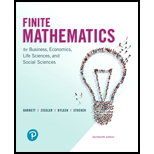
Problems 1-7 refer to the partially completed table of the six basic solutions of the
In basic solution
The variables which are basic from the basic solution
Answer to Problem 1RE
The basic variables are
Explanation of Solution
Consider the given
The variables that have been assigned the value zero are non-basic variables and others that have not been assigned the value zero are termed as basic variables.
Basic solution
Thus, from the basic solution of the
Therefore, the basic variables are
Want to see more full solutions like this?
Chapter 6 Solutions
Finite Mathematics for Business, Economics, Life Sciences, and Social Sciences (14th Edition)
Additional Math Textbook Solutions
University Calculus: Early Transcendentals (4th Edition)
A Problem Solving Approach To Mathematics For Elementary School Teachers (13th Edition)
Algebra and Trigonometry (6th Edition)
Elementary Statistics: Picturing the World (7th Edition)
Thinking Mathematically (6th Edition)
- (1) (4 points) Give a parametrization c: R R³ of the line through the points P = (1,0,-1) and Q = (-2, 0, 1).arrow_forward7. Show that for R sufficiently large, the polynomial P(z) in Example 3, Sec. 5, satisfies the inequality |P(z)| R. Suggestion: Observe that there is a positive number R such that the modulus of each quotient in inequality (9), Sec. 5, is less than |an|/n when |z| > R.arrow_forward9. Establish the identity 1- 1+z+z² + 2n+1 ... +z" = 1- z (z1) and then use it to derive Lagrange's trigonometric identity: 1 1+ cos cos 20 +... + cos no = + 2 sin[(2n+1)0/2] 2 sin(0/2) (0 < 0 < 2л). Suggestion: As for the first identity, write S = 1+z+z² +...+z" and consider the difference S - zS. To derive the second identity, write z = eie in the first one.arrow_forward
- 8. Prove that two nonzero complex numbers z₁ and Z2 have the same moduli if and only if there are complex numbers c₁ and c₂ such that Z₁ = c₁C2 and Z2 = c1c2. Suggestion: Note that (i≤ exp (101+0) exp (01-02) and [see Exercise 2(b)] 2 02 Ꮎ - = = exp(i01) exp(101+0) exp (i 01 - 02 ) = exp(102). i 2 2arrow_forwardnumerical anaarrow_forward13. If X has the distribution function F(x) = 0 1 12 for x < -1 for -1x < 1 for 1x <3 2 3 for 3≤x≤5 4 1 for x≥5 find (a) P(X ≤3); (b) P(X = 3); (c) P(X < 3); (d) P(X≥1); (e) P(-0.4arrow_forwardTwo measurements are made of some quantity. For the first measurement, the average is 74.4528, the RMS error is 6.7441, and the uncertainty of the mean is 0.9264. For the second one, the average is 76.8415, the standard deviation is 8.3348, and the uncertainty of the mean is 1.1448. The expected value is exactly 75. 13. Express the first measurement in public notation. 14. Is there a significant difference between the two measurements? 1 15. How does the first measurement compare with the expected value? 16. How does the second measurement compare with the expected value?arrow_forwardNo chatgpt pls will upvote Already got wrong chatgpt answer .arrow_forwardIf you use any chatgpt will downvote.arrow_forwardPlease help I'm a working mom trying to help my son last minute (6th grader)! Need help with the blank ones and check the ones he got with full calculation so we can use it to study! Especially the mixed number fractions cause I'm rusty. Thanks in advance!arrow_forward|| 38 5층-11- 6 4 7 2 6arrow_forward4. Consider the initial value problem y' = 3x(y-1) 1/3, y(xo) = yo. (a) For what points (co, yo) does the IVP have a solution? (b) For what points (xo, yo) does the IVP have a unique solution on some open interval that contains 20? (c) Solve the IVP y' = 3x(y-1) 1/3, y(0) = 9 and determine the largest open interval on which this solution is unique.arrow_forwardarrow_back_iosSEE MORE QUESTIONSarrow_forward_ios
 Linear Algebra: A Modern IntroductionAlgebraISBN:9781285463247Author:David PoolePublisher:Cengage Learning
Linear Algebra: A Modern IntroductionAlgebraISBN:9781285463247Author:David PoolePublisher:Cengage Learning
